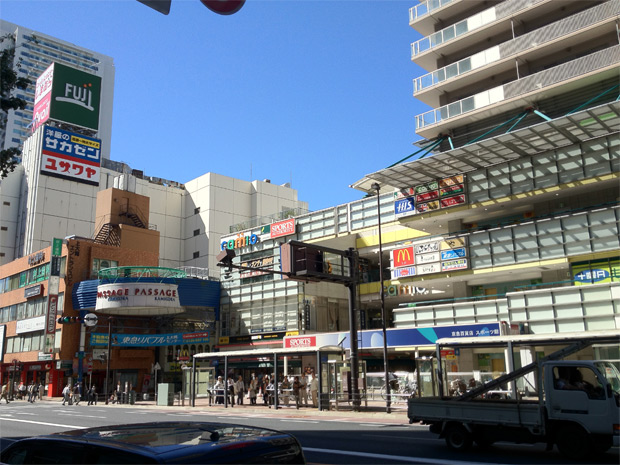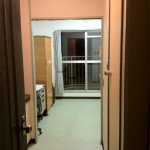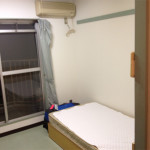A Couple of Notes for the Incoming Students, Part 1 (Updated! – 2017 Oct 20)
It’s about that time of the year where I remember I have a blog, I go in, and see more hits than usual, due apparently in part to search terms for the JOY program and odd things about the area in English. Maybe I should’ve written this earlier, but now that spring break is here (and I’m done with the usual handful of end-semester assignments I procrastinated on), I can actually sit down and write this up. Ahem.
To those of you who have decided to make Yokohama National University your university away from university for a semester or two, hi! My name’s Mattie, and I look forward to getting to know you, JOY-sei alumni 2012-2013. Lemme give you a preview of life as us ryuugakusei live it here in Japan to the best of my ability, shall I?
Oh, before that, though, couple of disclaimers: this was current at the time I wrote it (2-18-2013) revised it (2013/8/29); things probably will have changed. This isn’t an official guide or anything like that. This is also YNU-specific, so if you’re thinking of studying abroad and YNU isn’t on your list, things will naturally differ…I think that’s about it. Okay, onto the good stuff.
Quick Jump:
Part 1 (The Dorms, The Neighborhood, Commuter Passes)
Part 2 (Getting to School, Getting Comfy in Your New Place, Resident Registration, Cell Phones, Money)
Part 3 (Getting to Know Yokohama A Bit Better)
Your Pad (Also: Getting Here)
So if you’re part of the JOY Program, you’re gonna be living at the *deep breath* International Student House of Yokohama National University. It’s right next to two other YNU-affiliated properties: the YNU-attached middle school, and the Ooka residences, an apartment complex that’s newer, more baller, and therefore more expensive. In any case, we call our dorms the “Gumyoji dorms” for short, because we’re a three-minute walk away from the *deep breath* Gumyoji Station on the Yokohama Municipal Subway’s Blue Line. (I’m gonna assume that’s the case and write this up based on that because I’ve not yet heard anything to the contrary.) Despite the station and the area associated with it, the dorm itself is actually located in a suburb called Ooka, in the south ward of town. (If you’re as hype as I was the two weeks prior to my flight, you could set your default location on Google Maps to Minami-ku, Yokohama City, Kanagawa Prefecture and have fun looking around using their some-years-old Street View.)
In any case, the dorms are a bit old. It actually used to be a girls-only dorm (one of my predecessors, Tina, came in 2009, back when they sent the boys off to the very-close-to-campus Minesawa dorms), but (at least according to what I’ve heard) due to the earthquake that shook Japan back in 2011, less people decided they’d wanted to study in Japan (or at least in eastern Japan). So, one of the wings has since then turned into a boys’ wing, and now us JOY students are all together — which is pretty nice.
If you pinged your tutor while at the airport (as an aside, have several 100-yen coins ready to drop, those payphones are vicious!), the moment you arrive in the Yokohama City Air Terminal (YCAT) you’ll be greeted by your tutor (and possibly Hasegawa-sensei). You’ll know s/he’s your tutor because he’ll have a sign kindly handpainted with your name on it. 😉 Your tutor will then walk you through Yokohama Station and take you on the Blue Line to get to Gumyoji. Your tutors will guide you to your room, which looks roughly like this:
The room will initially have its electricity disabled; your tutors (or one of us) will fix this for you 😉 Also, do note that since the electricity powers the hot water heater, you will be unable to use hot water until the next day.
Your room comes with Internet in the form of a CAT5 Ethernet jack. You can request a Ethernet cord from the office if you’ve got a port to match. A wireless router is a pretty awesome thing to bring if you have multiple devices on you, but if not, that’s cool, too; you can buy one here in Yokohama, as well. The room may come slightly pre-furnished, but that’s pretty much about it: it doesn’t come with toiletries and stuff like that.
Dorm orientation will happen in the evening: do attend and get to know your RAs, or resident advisors — the Japanese students that live in the Gumyoji dorms, ready to assist people with stuff. They’re pretty friendly folks! There are actually two orientations: one’s in Japanese, and one’s in English.
Tip: Bring only what you need; don’t pack too many non-consumable things! Depending on how much you like purchasing physical things of any sort, you might have a hard time sending stuff back. I’ve heard tales of people having to pay numbers in the hundreds of US dollars/ten thousands of Japanese yen to ship goods back.
The Neighborhood – Welcome to Gumyoji

This is the Gumyoji Kannon-doori shopping street, the main draw for visitors to the area. There’s quite a number of stores here selling all kinds of things from food to electronics to coordinates to the toiletries you might not have packed and will probably want to purchase as soon as possible. Thankfully, there are lots of drug stores down this main alley that do sell those; just look out for the 薬 kanji (heck, Seijo and Create drugstores have prominent English signage). You might also be interested in fresh food — there are a handful of options for that, as well.
Two supermarkets serve this neighborhood: Piago and Shokuhinkan Aoba. Piago is closer and more convenient, and you’ll probably want to stop by the Seria 100-yen store situated on its third floor; Aoba’s food section (and thus selection) is bigger and is open later than Piago (Piago closes at 7 PM; Aoba closes at 10 PM on weekdays, 9 PM on weekends.) To get to Piago, go into the street and take a right when you see the Fujiya cake shop; it’ll then be on your left. For Aoba, just go straight, up the rather hilly road; it’s just past the Keikyu Gumyoji station. (There used to be a Piago supermarket here while we lived here, but it’s not there anymore as of 2017 Oct 15.)
Two supermarkets serve this neighborhood: Yokohamaya and Shokuhinkan Aoba. Yokohamaya is the closer of the two, but it opened up years after I left, so I don’t actually know how nice they are. What I do know is that Aoba’s food section is pretty dang good, and it’s open just a bit later than Yokohamaya on weekdays — 10 PM, as opposed to 9 PM. Yokohamaya is on the main Kannon-doori street, just across the bridge. For Aoba, just go straight, up the rather hilly road; it’s just past the Keikyu Gumyoji station tracks.
There are a couple of things that you might want that are best served by other shops that are just a train ride away. I think I can safely say none of us have ever been inside the electronics stores in the Kannon-doori, for example, but there’s a Yodobashi Camera in Kamiooka one stop down. And, actually, speaking of Kamiooka, lemme introduce that area to you, too.
Kamiooka and the Commuter Pass

To get to YNU, you take the subway for about 25 from Gumyoji to Mitsuzawa-kamicho station (hereafter Mitsu-kami), then walk for 20 minutes to school, making your one-way commute time 45 minutes. Your destination on the subway is an important thing to note, because not only do you need to know where the university’s located, it’s also gonna be the end-point for the commuter pass I highly recommend you purchase. Unfortunately, short-term foreign students, being “special” students, are for some reason ineligible for the student discount, no matter what benefits your home university may confer on your YNU counterparts. A handful of us who started in October were somehow able to obtain them, but supposedly now there’s a memo going around to all the stations, blocking new student commuter passes from being created (we’ve tried). So, pretty much, if you’re really, really lucky, you can attempt for, and get a student commuter pass — and if YNU realizes this, you’ll have to endure about two months’ worth of phone calls requesting you return the pass the university doesn’t want to subsidize. That’s the bad news.
The good news is, you’re not blocked from getting a general commuter pass; it just costs more. A commuter pass for a month from Gumyoji to Mitsu-kami costs you 10,140 yen. You can also opt for a three-month or a six-month pass, which affords you a very slight discount and are 28,900 and 54,760 yen, respectively. Your tutor can help you with purchasing a PASMO card (if you have any other IC card for some reason, that works too) that’s used not only for commuter passes, but used as automatic train fare (here’s a link to the official English guide).
The fares are calculated by “zones” of distance between stations. For this reason, Kamiooka, one stop down, is the same price as Gumyoji — and, for this reason, I suggest you get a Kamiooka to Mitsu-kami commuter pass. This is because Kamiooka not only is a major stop on the Keikyu line (making potential trips to/from Tokyo faster if you want to get there in a hurry), but because it has everything that Gumyoji doesn’t have in terms of entertainment options: it’s home to the closest movie cinema (Toho Cinemas Kamiooka) and malls (Wing Kamiooka/Keikyu Department Store, Camio, and Mioka), has a pretty decent up-to-date video game arcade, and has a really nice karaoke place that opened up not too long ago, among other things like a bowling alley and a bunch of restaurants. It’s also got a supermarket that’s open until 1 AM — if the FamilyMart next door to the dorms doesn’t stock what you need. But yeah, Kamiooka is pretty much the closest hub for entertainment if you wanna relax a bit from studying. Heading over to Kamiooka also makes for a bit of a good walk: the 1.8 kilometers (just over a mile) makes for a 22-minute stroll, which is really nice in the spring or autumn when it’s not too hot or not too cold.
You can also/instead get a bike, which makes the commute to school supposedly take an hour one-way. There’s no marked bike parking near the ISC, but ISC people just park them right outside of the ISC, under the eaves of the Education Hall — it’s fine. Of course, be sure to buy a lock (or get a bike with an integrated one). Yokohama has a handful of bike parking lots scattered around; some paid, some free. Thankfully, the paid ones are fairly cheap (something like 100 yen for a couple of hours?), last I remember.
That’s it for now; it’s 2:40 and I’m supposed to be up a bit earlier than usual tomorrow. Oops. In the next post: getting to school, and things to do here in Yokohama. If you’re an incoming student with a burning question, do comment below! ◆




this. has. saved. me.
thanks buddy so many great tidbits of info ^^
so excited to start in October!!
Dear Friend!!! Could you post more pictures of the dormitory please? Thanks…
Sure! Lemme dig through my archives and see what I’ve got, though I admittedly don’t have too many pictures…
Thanks so much, super helpful!
By the way I’m wondering whether it is possible for me to rent a bike for like one term, or buy second-handed ones? Buying a new one is…quite costly
Hi, Yang! Thanks for reading!
I’m not aware of any service that allows you to rent a bike long-term, but there’s a recycle shop (thrift store) by the name of Everyone in Isezakicho that claims to have used bikes, not too far off from Blue Line Isezaki-chojamachi station. Also, if you’re lucky, there’ll have been a bike or two left behind by a senpai who’s just left, but I wouldn’t count on it. In any case, hopefully the recycle shop’s got a bike at an OK enough price point for you!
If you’re part of the incoming wave of students next month, here’s wishing you all the best! 🙂
Thanks so much for the tips! I’m indeed going to YNU next month!
I’d also like to know the terrains on my way to the campus, is it hilly? Will it be super cold in winter lol…
You do have to walk uphill on the way to campus, so in that sense it is a bit hilly. There are two main paths people can take to school from Mitsu-kami: one in which you walk up stairs at the end of the path that goes straight to school, along the main road, and one off the beaten path that takes you through a road that cuts through a couple of cabbage farms. In case there’s not a senpai left that knows of the cabbage patch route, here’s a map:

It does get quite chilly in the winter, but your situation may vary: it was a lot colder in 2012 than when I visited last year in 2015/2016 for the same New Year’s time period. I’d definitely recommend having extra clothing to layer on if you need (and even if you don’t have some handy, there’s a Uniqlo in Kamiooka one stop away from Gumyoji — I quite like, and recommend, their Heattech thermalwear).
I’m coming to YNU in one month and your article was superhelpfull!!! 🙂 Thank you a lot!!
Hi, Veronika — thanks for reading, I’m glad you’re finding my blog to be of help! Let me know if you’ve got any questions, and all the best during your time abroad!
This blog is so helpful! I am considering going to YNU for my year abroad and this is so helpful!! One question though. If I understood correctly, in the accommodation there’s a women’s wing and a men’s wing, right? So no real mixing. And are there any curfews? Thank you again!
Heyo, Ruxandra! Thanks for stopping by and checking out the blog!
At the time I was studying abroad, the wings were separated (all the boys were in the “B” wing and all of the girls were in the “A” and “C” wings of the dorm), and accomodations are single rooms (unless you qualify for and take a family unit).
There are no curfews; you’re given a keycard to access the building at any time you’d like even when the main doors are shut. However, the dorm does ask its residents to be considerate during the nighttime (so no throwing parties, etc). That doesn’t prevent people from throwing parties, of course. 😉
Let me know if you have any other questions! 🙂
I’ve honestly been looking at this guide for 3 months here and there to calm my nerves and be prepared. I have 4 days until my flight; and I have to say, man, it’s getting to me. Your guide is seriously so helpful; it feels comforting to be able to have all of this information in mind before going… Thanks a lot dude!!
Hi, Tsu —
It just occurred to me that I hadn’t had the time to reply back! Thanks for checking out the blog — I’m glad my information’s helping! By now, you must’ve been settled in for a couple of weeks now — how’re you liking it?
Let me know if you have any other questions, or if anything major’s changed from when I was over there. I’m starting to think this blog is getting pretty dated, hahah…